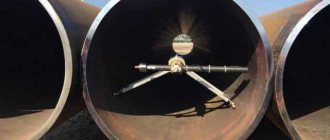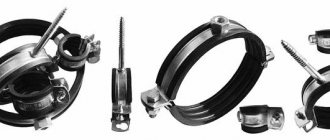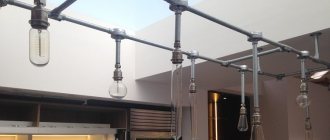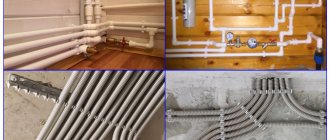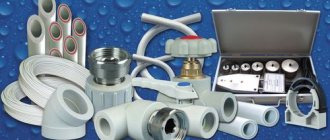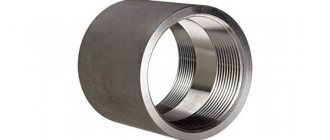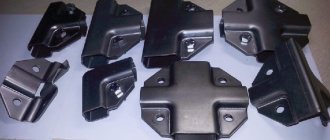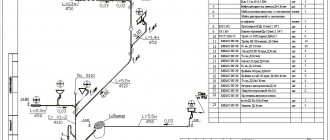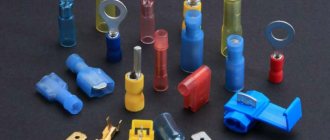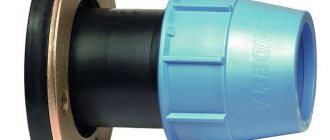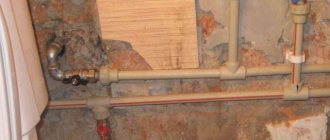Fastening process pipelines to building structures. Album T-MM-08-99
This album discusses various methods of securing pipelines to building structures using fasteners (brackets).
The T-MM-08-99 album provides the following types of fastenings:
- KSP - fastenings to wall panels;
- KSK - fastenings to brick walls;
- KKZH - fastenings to reinforced concrete columns;
- KKS - fastenings to steel columns;
- Gearbox - fastening to floor slabs;
- KP - fastenings to floors;
- KPM - fastenings to platforms;
- KRP - fastenings to crossbars on suspensions;
- KBP - fastenings to floor beams on hangers;
- KKM - fastenings to metal columns.
The fastening structures are designed for simultaneous exposure to horizontal and vertical design loads. Depending on the climatic version, the grade of steel from which the mount is made varies.
Advantages of Mupro steel clamps
Why should you choose products from a German company? The advantages of these products look like this:
- Vibration isolation. Thanks to special rubber, Mapro pipe clamps have a high level of vibration insulation. This gasket reduces vibration levels by approximately 19 dB(a).
- Thermal insulation. Modern rubber, in addition to its basic properties, has thermal insulation characteristics. They are capable of operating at maximum temperature range (from -60 to +225 degrees Celsius).
- Increased load capacity. Macro pipe clamps have a high load capacity and can withstand heavy loads.
- Impact resistance. The products have been tested. All parts of the clamps have been tested for impact resistance, which significantly reduces the likelihood of mechanical damage.
- Convenient fastening. The clamp is connected by two locking screws; they are needed for better fit and fixation with a non-falling washer.
- Color stripes. All pipe fastening products have special strips. This provides a guide to the wide range of this product. They indicate the area of application, which eliminates errors when purchasing.
- Possibility of ordering. If there is no suitable model, then individual production of non-standard products of any size is possible.
Steel fasteners are not only able to withstand high mechanical loads, but can also maintain an excellent seal to support pipes of any diameter. They are used in plumbing, automotive, and in the installation of heating and ventilation systems.
Fastenings to brick walls
Fastenings KSK 1
Brand : KSK 1
Fastenings KSK 2
Brand : KSK 2
Fastenings KSK 3
Brand : KSK 3
Fastenings KSK 4
Brand : KSK 4
When to use steel pipes
According to GOST 3262-75, a pipe is defined as a water and gas pipe. The standard states that it can be used equally in conditions of transportation of water and gas, or in the structural parts of the corresponding pipelines. They are also installed in heating, irrigation, cooling systems, etc.
Water supply steel pipes are used:
- in pressure pipelines;
- in earthquake-prone regions;
- in highly porous soils;
- when installing siphons (pressure pipeline sections laid along the bottom of a ravine, under a river bed or under a low-lying road);
- when installing water pipelines on overpasses or bridges;
- in places subject to mechanical stress, including vibration loads.
Fastenings to wall panels
KSP mounts 1
Brand : KSP 1
KSP 2 fastenings
Brand : KSP 2
Fastenings KSP 3
Brand : KSP 3
Fastenings KSP 4
Brand : KSP 4
Fastenings KSP 5
Brand : KSP 5
Advantages and disadvantages of steel pipes
Due to their positive characteristics, steel pipes do not have the disadvantages inherent in alternative products used for the installation of water supply networks and wiring. Although, like any other material, steel also has negative aspects in operation.
Advantages
A metal water pipe made of steel has a high level of mechanical strength. It can be installed to transport pressurized fluid under floor coverings in areas with heavy foot traffic. In these cases, water conduits made of steel pipes are the best choice among analogues.
When pumping equipment operates, pipelines are subject to vibration loads. In addition, they take on pressure drops at the moment when water pumping starts.
Another advantage of a steel water pipe is its price. It is not the cheapest, but it is among the affordable ones. Another interesting fact is that in a home workshop you never know who has several meters of plastic pipe, but a half-inch steel pipe will probably be found somewhere in the storage room.
The next important point is the low coefficient of expansion of steel under thermal load. When laying open, practically no attention is paid to this, but in the case of laying a water pipeline in a screed, this fact is of significant importance.
Products with a high rate of thermal expansion can cause cracks in concrete.
Another advantage of steel pipes is the availability of any fittings even in the smallest store or outlet. But complex connecting parts, for example for polypropylene pipes, sometimes take a long time to find.
Flaws
A significant vulnerability of steel water pipes is considered to be their susceptibility to corrosion processes. Rust can gradually lead to the appearance of fistulas, and in the worst case, to the complete destruction of the material. Especially often, cold water supply pipelines suffer from the appearance of condensation on their outer surface. When it interacts with oxygen, the pipe begins to rust, so it needs periodic painting.
Another trouble awaiting the owner of a steel water pipeline. This is a reduction in pipe capacity. The fact is that over time it begins to “overgrow” due to the appearance of rust and an increase in the thickness of its layer. Suspended particles also settle on it, which ultimately renders the pipeline unusable. In this case, it must be completely replaced.
The weight of steel pipes plays an important role. It is much higher than the indicator related to plastic analogues.
Another disadvantage that should be mentioned relates to the complexity of installation work. Laying technology requires the involvement of a highly qualified welder with his own equipment. Even threaded connections with couplings are often reinforced by welding.
Floor fixings
Mounting gearbox 1
Brand : KP 1
KP 2 mounts
Brand : KP 2
KP 3 mounts
Brand : KP 3
KP 4 mountings
Brand : KP 4
Fastenings KP 5
Brand : KP 5
Types of clamps
By design
Structurally, clamps are divided into 3 types:
- A ring that opens on one side and a movable detachable connection on the other side. The connection is secured with a bolt.
- Two half rings, which are fastened together with bolts.
- The bracket is shaped like the letter U. This type of fastener can have a rubberized gasket or surface inside, or be completely metal.
By task
Clamps are divided based on the tasks performed:
- Spiral
- Power
- Reinforced
- Wire
- Worm
- Pipe mortise
Details
SPIRAL
Spiral clamps are divided into two types, the difference between them is only in the rotary tightening mechanism, left or right tightening direction. Main lines made of reinforced pipes are used.
The part is a tape with a tightening mechanism. Direct purpose: fastening pipes under pressure. It is especially convenient to use for rectangular pipes, for rigid hoses, for hydraulic pneumatic drive systems, for hoses with rigid walls and reinforcement.
Fix pipes with stronger pressure. Used for rigid or reinforced hoses. The limited length of the hinge screws ensures fixation with a small difference in the internal cross-section. Withstand pressure up to 30 atm. And they have decent strength.
WIRE
The design of the product is one or several rings of zinc-coated steel wire. They do not deform during long-term use. The optimal operating option for corrugated products, for pipes with thin soft walls and for systems with increased vibration.
According to the tightening method, wire clamps are divided into two types:
- Screw fastening. For connecting spiral hoses.
- With spring-type fasteners. For its fastening there are special “ears”, which are clamped/pressed with fingers to increase/decrease the diameter of the product, without requiring any additional tools.
Externally, the clamp looks like a monolithic gear track made of metal, with a tightening screw. A clamp with this design has uniform tightening. Used for durable installation of hoses and pipes that are subject to vibration, as well as in heating systems and plumbing systems.
The design is a round ring made of a metal plate with a rubber liner inside. Clamping is carried out on one or both sides using a bolt. This type of product is used for fastening open pipes in a certain area to reduce system stress and high-quality fixation of the pipe position.
ALL CLAMPS WITH A SEALING IN THE FORM OF A RUBBER GASKET ARE USED FOR SPECIFIC PURPOSES: TO REDUCE PIPES VIBRATION, TO REDUCED SHIMM, TO INCREASE THE TIGHTNESS OF THE CONNECTION.
THE COST OF CLAMPS WITH RUBBER INSERTS IS ALWAYS HIGHER.
Tinder SHV and SGV are used for fastening due to exposure to high temperatures, which lead to expansion and various kinds of deformations.
